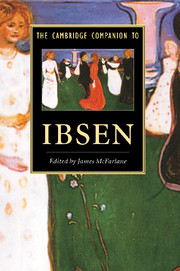Book contents
- Frontmatter
- 1 Ibsen's dramatic apprenticeship
- 2 Ibsen and historical drama
- 3 Dramatic and non-dramatic poetry
- 4 Ibsen and comedy
- 5 Ibsen and the realistic problem drama
- 6 Ibsen and feminism
- 7 The middle plays
- 8 The last plays
- 9 Ibsen's working methods
- 10 Ibsen and the theatre 1877-1900
- 11 Ibsen and the twentieth-century stage
- 12 Ibsen on film and television
- 13 On staging Ibsen
- 14 Ibsen and the drama of today
- 15 A century of Ibsen criticism
- 16 Works of reference
- Index
7 - The middle plays
Published online by Cambridge University Press: 28 May 2006
- Frontmatter
- 1 Ibsen's dramatic apprenticeship
- 2 Ibsen and historical drama
- 3 Dramatic and non-dramatic poetry
- 4 Ibsen and comedy
- 5 Ibsen and the realistic problem drama
- 6 Ibsen and feminism
- 7 The middle plays
- 8 The last plays
- 9 Ibsen's working methods
- 10 Ibsen and the theatre 1877-1900
- 11 Ibsen and the twentieth-century stage
- 12 Ibsen on film and television
- 13 On staging Ibsen
- 14 Ibsen and the drama of today
- 15 A century of Ibsen criticism
- 16 Works of reference
- Index
Summary
Rebecca, Ellida, Hedda: the three heroines of Ibsen's plays from this period, Rosmersholm (1886), The Lady from the Sea (1888) and Hedda Gabler (1890), have names which have a similar ring to them; all sound slightly unfamiliar to a Norwegian ear, have an air of 'otherness' which marks them off from convention. The centrality of the heroines in these plays is underlined by the fact that two of them give the plays their titles, the only Ibsen plays where this occurs apart from the early Lady Inger (1857) - whereas as many as ten plays refer to the names or functions of male characters in their titles (Catiline, OlafLiljekrans, The Pretenders, Brand, Peer Gynt, Emperor and Galilean, An Enemy of the People, The Master Builder, Little Eyolf, John Gabriel Borkman).
The otherness of these heroines is apparent from the beginning of the action; all are outsiders in their society, at odds with the mores of the community in which they find themselves, unhappy with an environment which forces them to live inauthentically. They have all to a greater or lesser extent tried to conform, but at the cost of the repression of their 'wild side'. They are pagans living in a Christian society. All are passionate women who, it could be argued, have got themselves involved with the wrong man. Neither Rosmer, Wangel nor Tesman are as their partners would have them be; they lack the passion to respond to their women's needs. As a result all three women have focused their sensuality on a substitute figure. Rebecca has invented for herself an idealized 'Rosmer' who bears little resemblance to the actual man, Ellida recalls her dream lover from the past and Hedda turns her energies to rekindling her highly charged relationship with Lovborg. The clash between aspiration and reality drives them all to breaking point.
- Type
- Chapter
- Information
- The Cambridge Companion to Ibsen , pp. 106 - 125Publisher: Cambridge University PressPrint publication year: 1994
- 2
- Cited by



